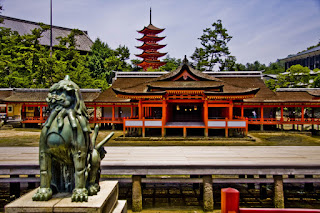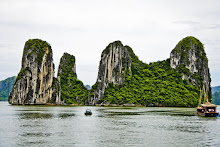Itsukushima (厳島 ?) is an island in the Inland Sea of Japan. It is popularly known as Miyajima (宮島 ?), the Shrine Island. Itsukushima is part of the city of Hatsukaichi in Hiroshima Prefecture. The island was the town of Miyajima prior to the 2005 merger with Hatsukaichi.
Itsukushima is famous for the Itsukushima Shrine, a UNESCO World Heritage Site. According to records, the shrine was established in the time of Empress Suiko. The warrior-courtier Taira no Kiyomori gave the shrine its present form. In 1555, Mōri Motonari defeated Sue Harukata at the Battle of Miyajima. Toyotomi Hideyoshi built a large building, the Senjō-kaku, on a hill above the shrine.
The island of Itsukushima, including the waters around it (part of Seto Inland Sea), and are within Setonaikai National Park.
Itsukushima is mountainous and sparsely settled. It does have an elementary school and a middle school. There are no traffic signals.
Frequent ferry services, operated by JR West (JR Miyajima ferry) and by Miyajima Matsudai Tourist Ship, carry traffic between the island and the mainland. The trip takes about ten minutes. There is an hourly express passenger ferry to Hiroshima harbour.
Miyajima's maple trees are renowned throughout Japan, and blanket the island in crimson in the autumn. Momiji manju, pastries filled with azuki jam or custard, are popular souvenirs, and carry maple-leaf emblems. Many other varieties such as chocolate and cheese are also available. Because the island is seen as sacred, trees may not be cut for lumber. Deer and monkeys roam freely. Deer are thought of as sacred in the native Shinto religion because they are considered messengers of the gods.
Itsukushima is mountainous and sparsely settled. It does have an elementary school and a middle school. There are no traffic signals.
Frequent ferry services, operated by JR West (JR Miyajima ferry) and by Miyajima Matsudai Tourist Ship, carry traffic between the island and the mainland. The trip takes about ten minutes. There is an hourly express passenger ferry to Hiroshima harbour.
Miyajima's maple trees are renowned throughout Japan, and blanket the island in crimson in the autumn. Momiji manju, pastries filled with azuki jam or custard, are popular souvenirs, and carry maple-leaf emblems. Many other varieties such as chocolate and cheese are also available. Because the island is seen as sacred, trees may not be cut for lumber. Deer and monkeys roam freely. Deer are thought of as sacred in the native Shinto religion because they are considered messengers of the gods.
A style of wooden spoon used to serve cooked rice, without impairing the taste, is said to have been invented by a monk who lived on the island. This style of spoon is a popular souvenir and there are some outsized examples around the shopping district.
The peak of Mount Misen, at 535 m, is the highest point on the island. Miyajima Ropeway carries visitors to within a 30-minute hike to the top. There are several sites related to the historical Buddhist priest Kōbō Daishi near the top. The island also contains the Miyajima Natural Botanical Garden.
Source: Wikipedia
The peak of Mount Misen, at 535 m, is the highest point on the island. Miyajima Ropeway carries visitors to within a 30-minute hike to the top. There are several sites related to the historical Buddhist priest Kōbō Daishi near the top. The island also contains the Miyajima Natural Botanical Garden.
Source: Wikipedia











































